Few summer transfers caught the headlines quite as much as the €120 million deal which took Antoine Griezmann from Atlético Madrid to Barcelona in 2019. It had it all, a star player, two big clubs, rivals for the same title, a big money deal, over a year of speculation and rumours… But no clear tactical fit for the player at his new club.
Since his arrival at Camp Nou, question marks have been raised. Under Ernesto Valverde, it seemed that there was no plan for the Frenchman. Coming from Atlético Madrid, he was the star man in Diego Simeone’s system. A team had been built around the notion of getting the best out of Griezmann. In Catalonia, that is far from the case and it has been evident in his first few months as he has struggled to find the right role for him.
This tactical analysis will provide a scout report of Griezmann’s first season at Barcelona, across La Liga, the Champions League, Spanish Super Cup and Copa del Rey, summarising the impact that he’s made and whether he’s lived up to expectations. By looking at which position he has played in within Barcelona’s tactics, his clinicality in front of goal and his general contribution, it is possible to assess Griezmann’s debut season through this analysis.
Is he misused?
One of the biggest concerns upon Griezmann’s arrival was where he would fit in within the Barcelona attack and it is one which continues to concern Barcelona fans across the globe as he remains without a settled role even as we near the end of his first full season at the club.. Using Wyscout’s judgement, he has started a game in the same position for four consecutive games just once since joining Barcelon: It is evident that neither Valverde nor Setién have had a clear role for Griezmann.
That said, he has predominantly played on the left flank, the position many expected him to take up given the dominance of a certain Lionel Messi on the right and with Luis Suárez through the middle. More recently, injury to the Uruguayan has seen Griezmann shift into a more central role but he has been used out wide for much of the campaign, simply as the coaches are not ready to displace Suárez.
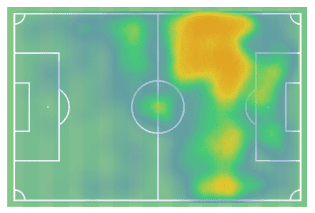
Such a role is far from exploiting Griezmann’s talents and involves featuring him in a role which he had not played in regularly at club level since he joined Atlético Madrid from Real Sociedad in 2014. The main reason for this is that from wide positions, Griezmann is not given such a direct route to goal. Usually willing to take men on, he rarely does so from wide positions, explaining why his dribbles per 90 have dropped by 27% compared to last season.
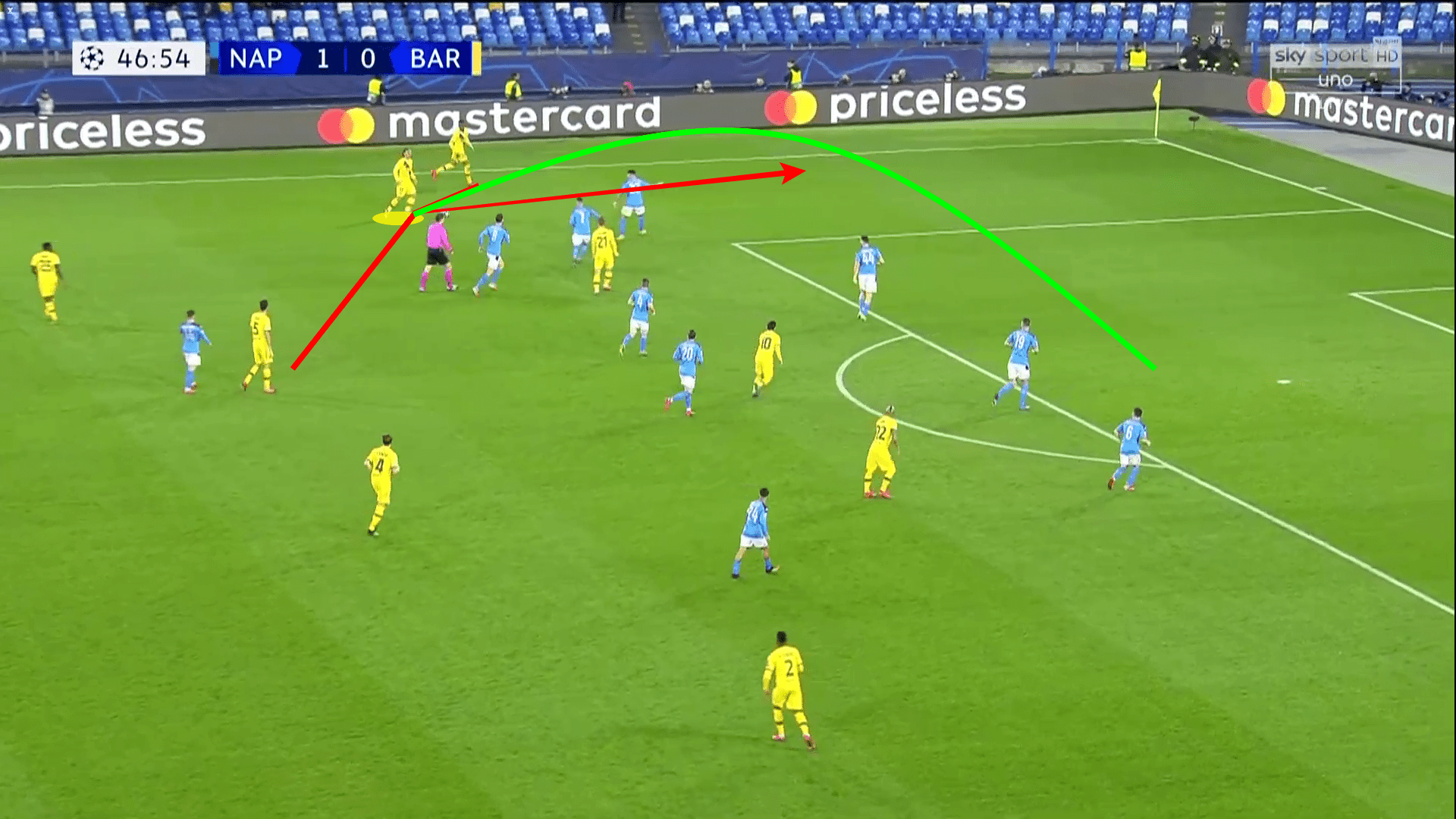
Instead, particularly against more defensive sides such as the below example against Napoli in the Champions League, he finds himself playing hopeful crosses or more direct passes into the danger area, or instead playing a simple but ineffective return pass to his defenders. Without the pace of the game in his favour, Griezmann instead finds himself often slowing play down and taking several touches. In a Barcelona side who are built around possession football and quick passing, he quickly stands out like a sore thumb.
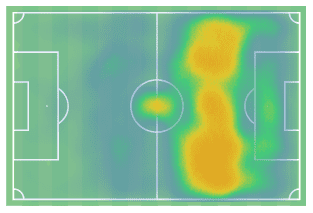
In his final season at Atlético Madrid, it was clear, as can be seen from his heat map, that he had an almost free role which he used to focus in central areas, with a slight tendency to drift to the right primarily due to the presence of Atlético’s more offensive wide midfielder typically being on the left.
This change, from a central role to the left flank, and importantly also to bring much more structure to his positioning, has limited his effectiveness. Whilst he should be creating more chances from these wide areas, his xA (Expected Assists) is actually 0.08 lower from a wide position than from a central one. By deploying him out wide, Barcelona are simply wasting a valuable asset.
What about when in his best position?
With this in mind, Griezmann must be more efficient when playing in a central role. Largely, he is. Beyond even his xA, he also records 0.05 more xG when playing through the middle. Griezmann is at his most comfortable in this role and is also far more effective. This comes through knowing the role and being able to use it to his strengths, treating it similarly to his roles with France, often playing alongside a partner, or his past experiences at Atlético Madrid.
Primarily, such a role allows him greater freedom to drop off. He has replaced Suárez during his injury absence but could not be more different in profile and approach to the former Liverpool centre-forward. Griezmann is a more free-moving forward who would typically prefer to play in a deeper role and run at the defence to break through at the last moment, rather than playing in the most advanced role possible and get involved in a physical battle. With Suárez sidelined and Martin Braithwaite the only other alternative, this role has been thrust onto Griezmann regardless since mid-January.
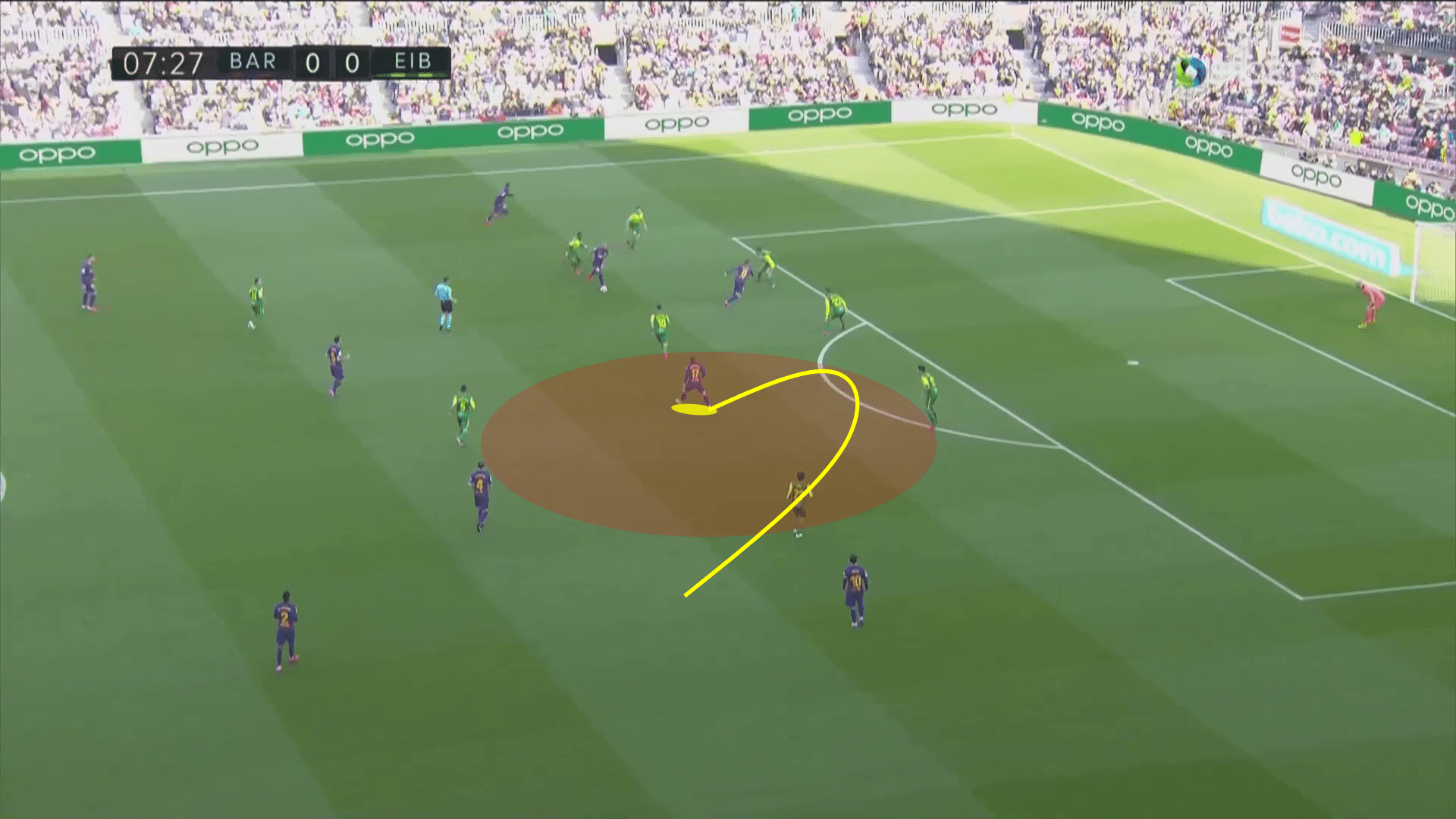
Equally, his positioning is very different to his team-mate and is actually more suited to him in a central role to the role that he would typically play in. Just like at Atlético, he rarely hangs on the shoulder of the last man in the way that Suárez does, instead dropping into the gap between midfield and defence and looking to exploit the weakness that comes as teams overload Messi by man-marking and taking one or even two players out of the equation. Here, such as against Eibar, Griezmann cuts back his run in order to exploit a gap which defenders are often slow to close down.
The challenge with this comes in that this is also the area typically occupied by Messi. Much like the free role that Griezmann had at Atleti, the number 10 will drift into these deep central areas. In many cases these are the same ones that Griezmann is looking to occupy, resulting in worse results for both players. All they effectively achieve is to bring more defenders’ attention to the areas and they apply more pressure. As the season has gone by, this has become a less frequent occurrence but it does lead to come overcrowding in the area that Griezmann is most keen to exploit.
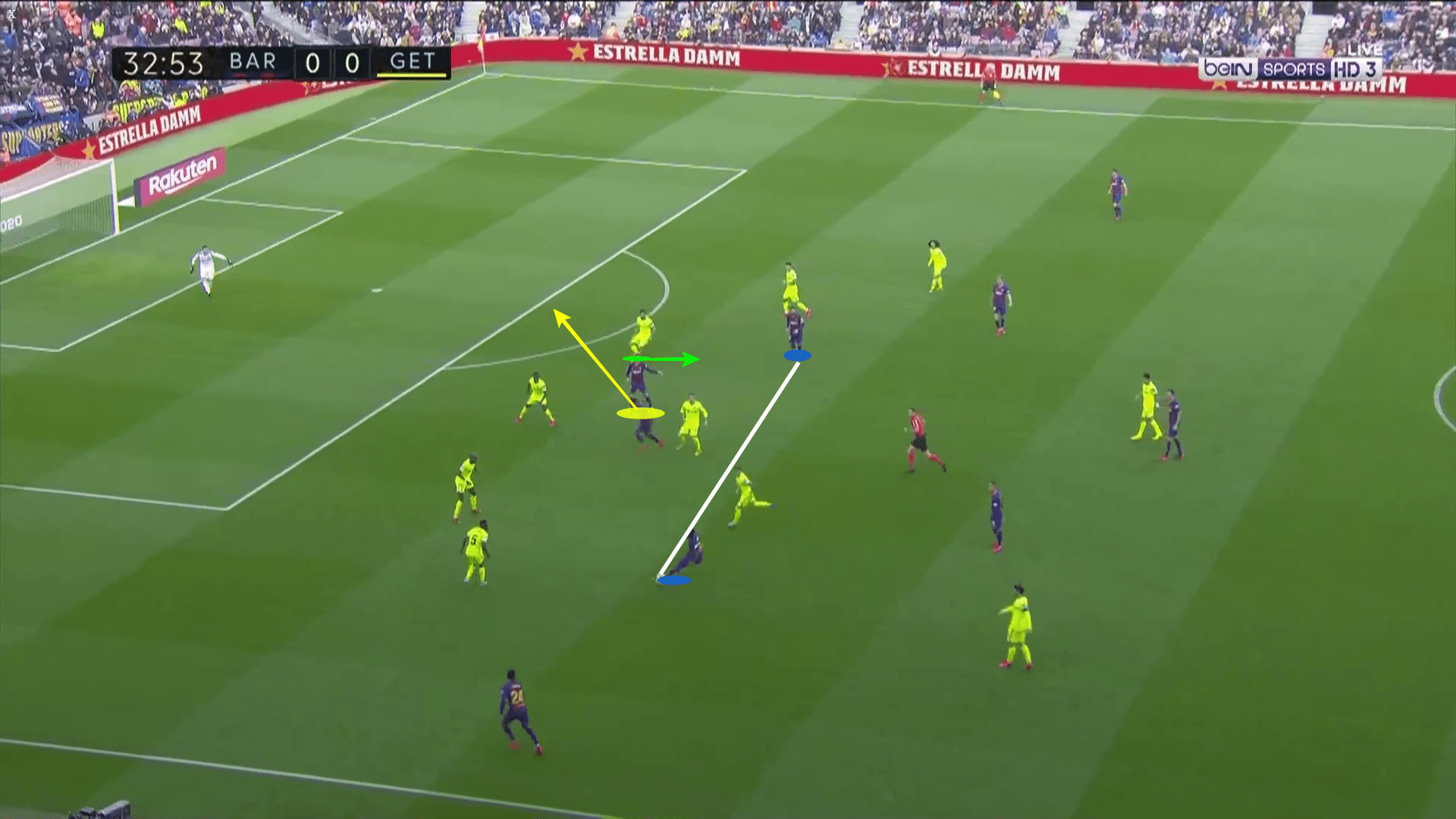
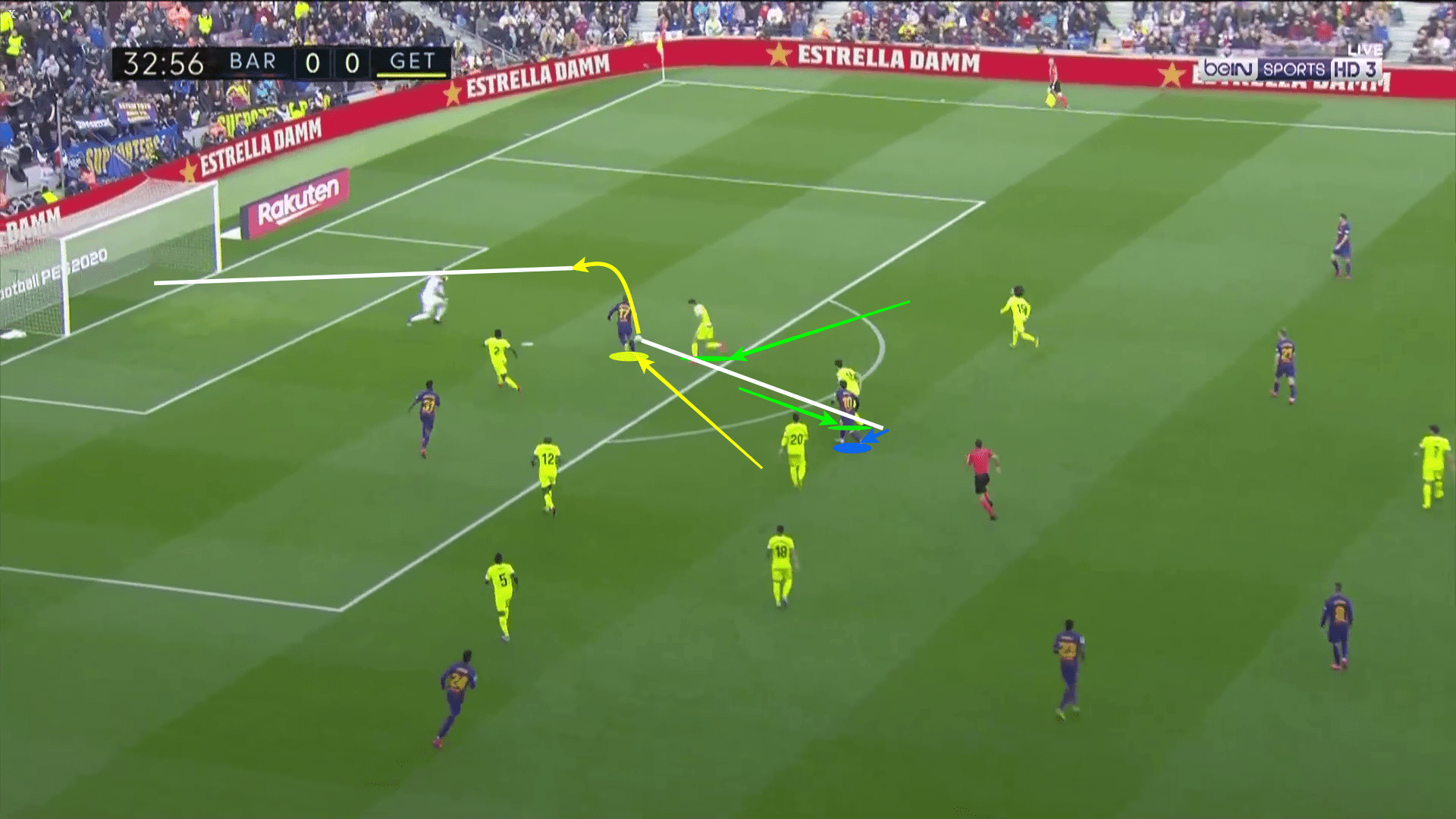
There have been signs of this relationship becoming more fluid as Grizmann has continued to feature in the centre-forward role and build up consistency for the first time. His goal against Getafe showed superb link-up play, anticipating the defender’s movement to close down Messi in the deep central role and using it to his advantage to find space in the box.
With time, this may become a more natural manoeuvre for Griezmann and his attacking companions at Barcelona. For now though, with Suárez the established centre-forward and with a lack of options on the left flank whilst Dembélé is sidelined, he may find his chances in this role to be more limited than he would like.
Is he as clinical?
Another big change for Griezmann coming into this Barcelona side related to his role in terms of his importance to the team. While at Atlético he was the main man and leading the goalscoring charts, doing so in fact for five consecutive seasons, that was never going to be the role that he would have at Barcelona. With Messi and Suárez around him as the team’s established and proven goalscorers, this was always going to be a challenging proposition for Griezmann.
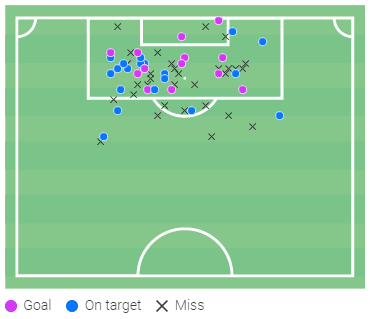
This season, he has required 0.71 xG for each goal scored. That is an admirable record, superior to Suárez’s 0.82 xG per goal, Karim Benzema’s 1.11 xG per goal scored and even Lionel Messi, who has recorded 0,78 xG for each goal. Yet, his shooting accuracy has fallen, with only 45% on target, a 0.8% decrease on last season and a 5.2% decrease on the previous season, which has led to harsh questions about his clinicality in front of goal.
Much of this is down to Barcelona’s approach and the fact that they tend to play against more teams who line up with a low defensive block. This means that Griezmann is forced to take more of his efforts close to goal, as shown by his shot map. In many cases, speculative efforts from distance are unattainable due to the number of defenders in front of him and so he is forced to rely more heavily on the last man’s shoulder and breaking through the lines. That’s why his xG per shot has actually increased, from 0.11 xG per shot in 2018/19 to 0.14 xG per shot in 2019/20.
His conversion rate has also improved. With this greater quality of chances, he has scored with 20% of his shots this season, compared to 16% in his farewell campaign at Atlético. Yet that is largely down to the reduced number of shots, going from averaging 2.77 shots per game to recording 1.97 shots per game, reflecting his new role at Barcelona without the same offensive influence.
This is equally reflected in his confidence in front of goal. There is no better example than when Griezmann faced his former side in the Spanish Super Cup. Through on goal with only Jan Oblak to beat, he took one touch too many to allow Oblak to close him down, narrow the angle and make what was eventually a fairly simple save. That one touch too many is one which has been seen time and time again this season, particularly when cutting into the box from a wide position and breaking a defensive line.
When compared to last season at the Estadio Metropolitano, he was more clinical with his chances. By looking at the stats alone, he scored one goal for every 0.68 xG, not a major difference but still an improvement. It is worth considering here, that the figure of 0.68 was his second worst in a season for Atlético, having recorded 0.58 xG per goal in 2017/18 and 0.63 xG per goal in 2015/16.

By simply looking at his shot map, we can see how his varied role at Barcelona has made an impact on his shooting when compared to his shots from last season. This season, 82% of shots come from within the 18 yard box, compared to 72% at Atletico Madrid. While he is yet to record a single goal from outside the box, registering just four shots on target from such positions, he scored 13 goals from such positions for Atlético over the past four seasons. Tactically, his role at Barcelona is far different and it is affecting not only how many goals he is scoring, but also the type of goals he is scoring.
What else does he bring to Barcelona?
If there was one element where Griezmann was always the perfect match, it was in the role that he played as a defensive aspect of the team’s attack. Well-drilled by Simeone during his time at Atlético, Far from being a major motivation behind the move, it is an intriguing one tactically as it provides Barcelona with more agility and more defensive cover with the Frenchman dropping in from attack to support his team-mates.
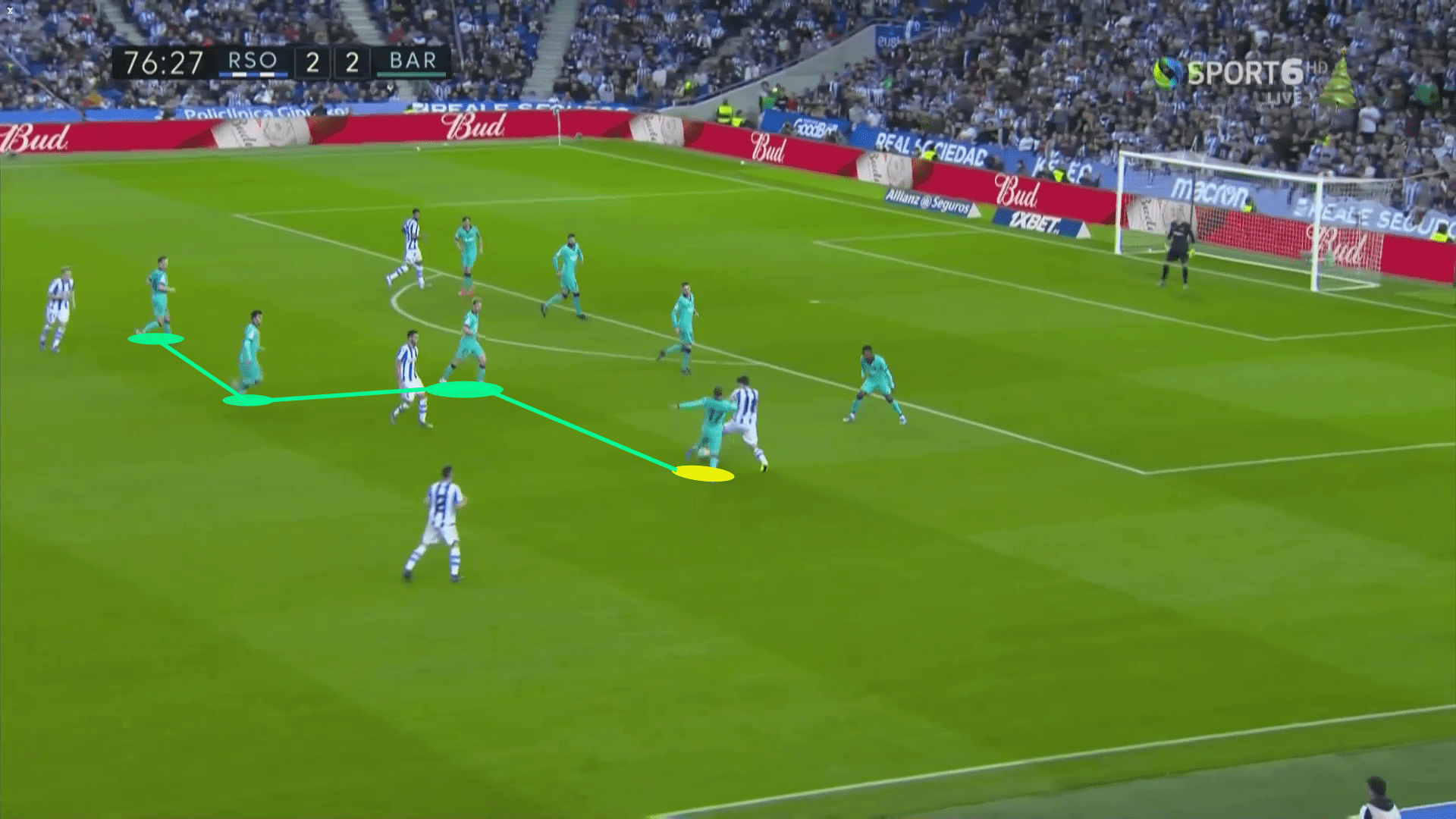
This makes for an interesting tactical option for Barcelona. Neither Valverde or Setién have (yet) been brave enough to consistently change the formation away from Barcelona’s traditional 4-3-3 shape, but Griezmann does provide some flexibility to that. Unlike Messi, Suárez, Dembélé or Fati, he is able to drop back in and almost operate as a fourth midfielder on the flank. This is an approach which was regularly taken up by Valverde, such as in this example against Real Sociedad, allowing him to drop deep both in and out of possession and then using him as a key element in the transition to turn that move around.
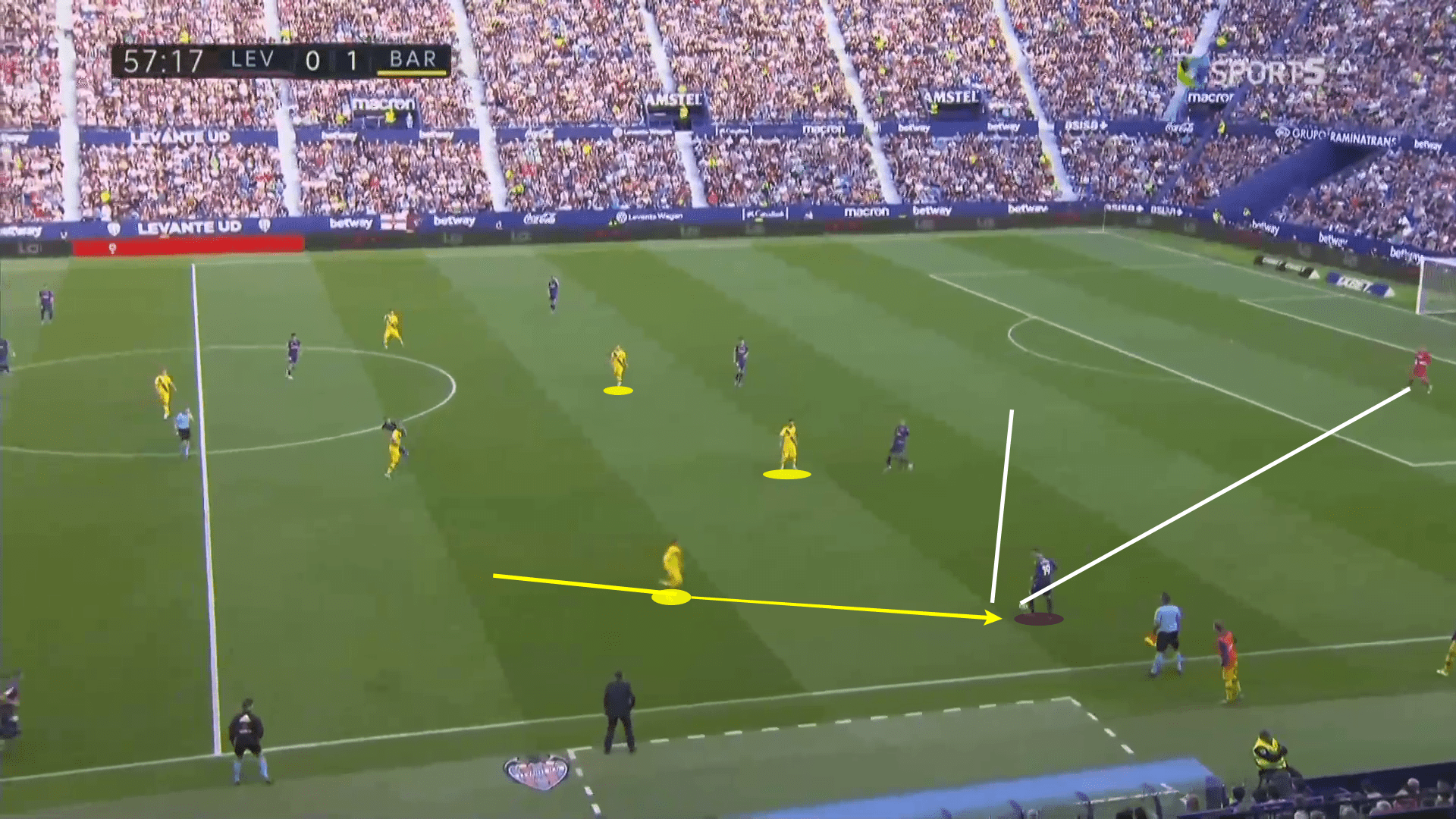
Equally, it has also allowed Barcelona to be more effective in their press. This season the PPDA (Passes Allowed Per Defensive Action) for Barcelona has dropped to 8.23, their lowest figure since 2016/17 and Luis Enrique’s departure from the dugout. That has been partly down to Setién’s tactics since his arrival but also down to the role played by Girezmann. When lining up alongside Messi and Suárez, he is almost exclusively responsible for the press in the opposition third, recording 2.53 interceptions per 90 minutes whilst Messi registers 0.98 and Suárez 1.55 with even Dembélé and Fati having 1.45 and 1.42 respectively.
This new approach to defending from the front is one which does give cause for optimism regarding Griezmann’s future at Camp Nou. Under Setién, this approach is likely to become more prevalent, provided the board allow him to implement his vision for the club. Reducing Griezmann’s defensive workload by sharing the press among his team-mates will allow him to be more effective when on the attack.
Conclusion
As this tactical analysis shows, it is blatantly clear that Griezmann was brought to Camp Nou without a clear idea of what role he would have to play. Neither of his coaches has had a clear game plan for him at any point this season, frequently varying his position and role. In such circumstances, it is not surprising that he has suffered in terms of consistency, having knock-on effects on his confidence and clinicality in front of goal.
With Suárez increasingly struggling to remain fit for a full campaign and with his stats and performances worsening with age, Griezmann’s long-term future, if it is in Barcelona, would almost certainly depend upon him being given the role of the team’s centre-forward. There, he has been at his most efficient, but it is a role where he is treading on the toes of Messi and still has plenty of work to do to adapt from Atlético’s style to that of Barcelona.
It is not all bad for Griezmann though. His finishing has actually been good, with a more clinical xG per goal than any other forward at the club. Equally, he provides the coach with a much needed and valuable tactical flexibility given his defensive work-rate. Whilst it may not be the best case to use to make judgements, the arrival of Braithwaite backs up the notion that Setién wants rounded forwards who will put in the leg work to defend from the front. Griezmann is one of the best in the game in that regard.
The easiest way to assess Griezmann’s debut season would be to label it a failure of management, and perhaps even a tactical failure. With no clear role or position for him, his arrival is illogical. In terms of performances, it is clear that he is not yet fully comfortable. Even with that in mind, his performances have produced goals and chances for the Catalan side. Don’t write him off yet.

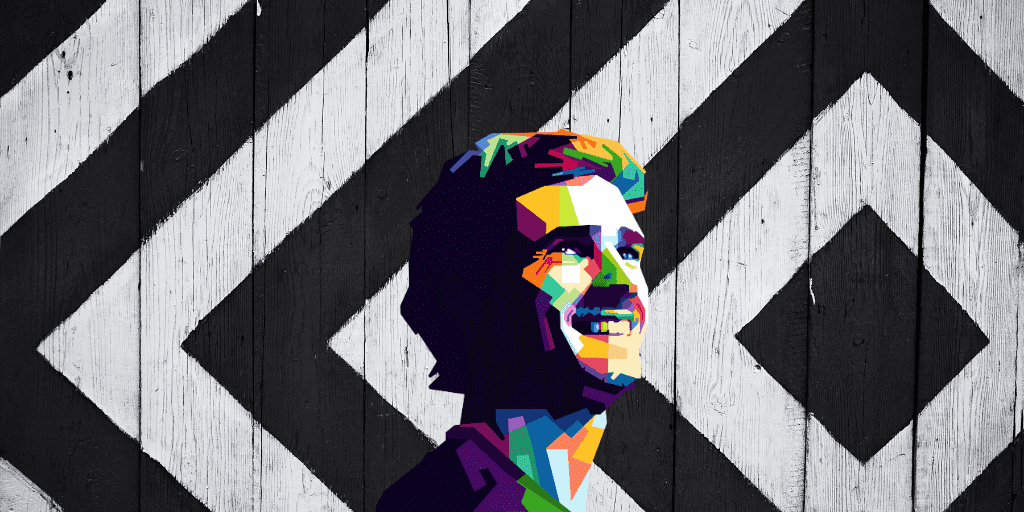



Comments